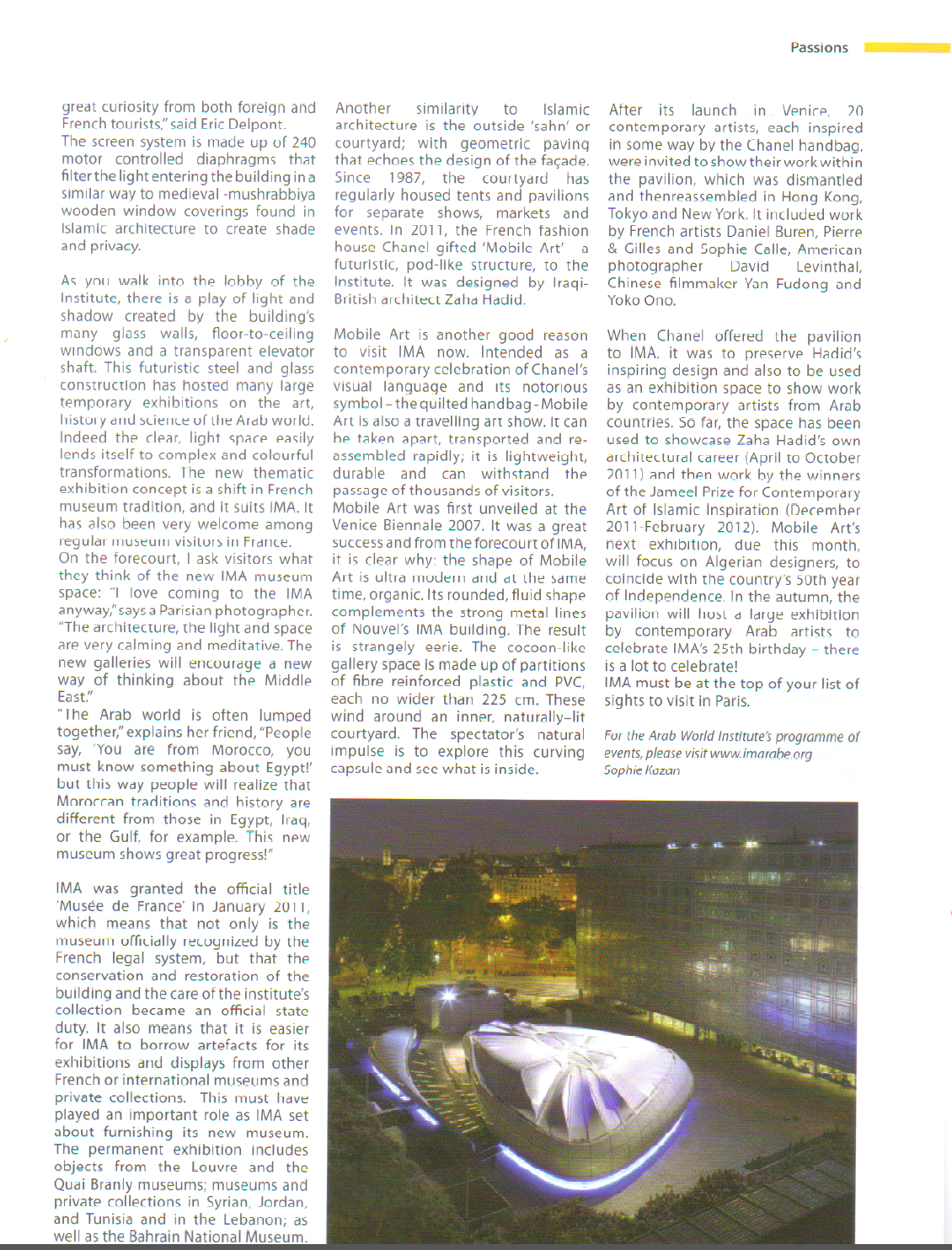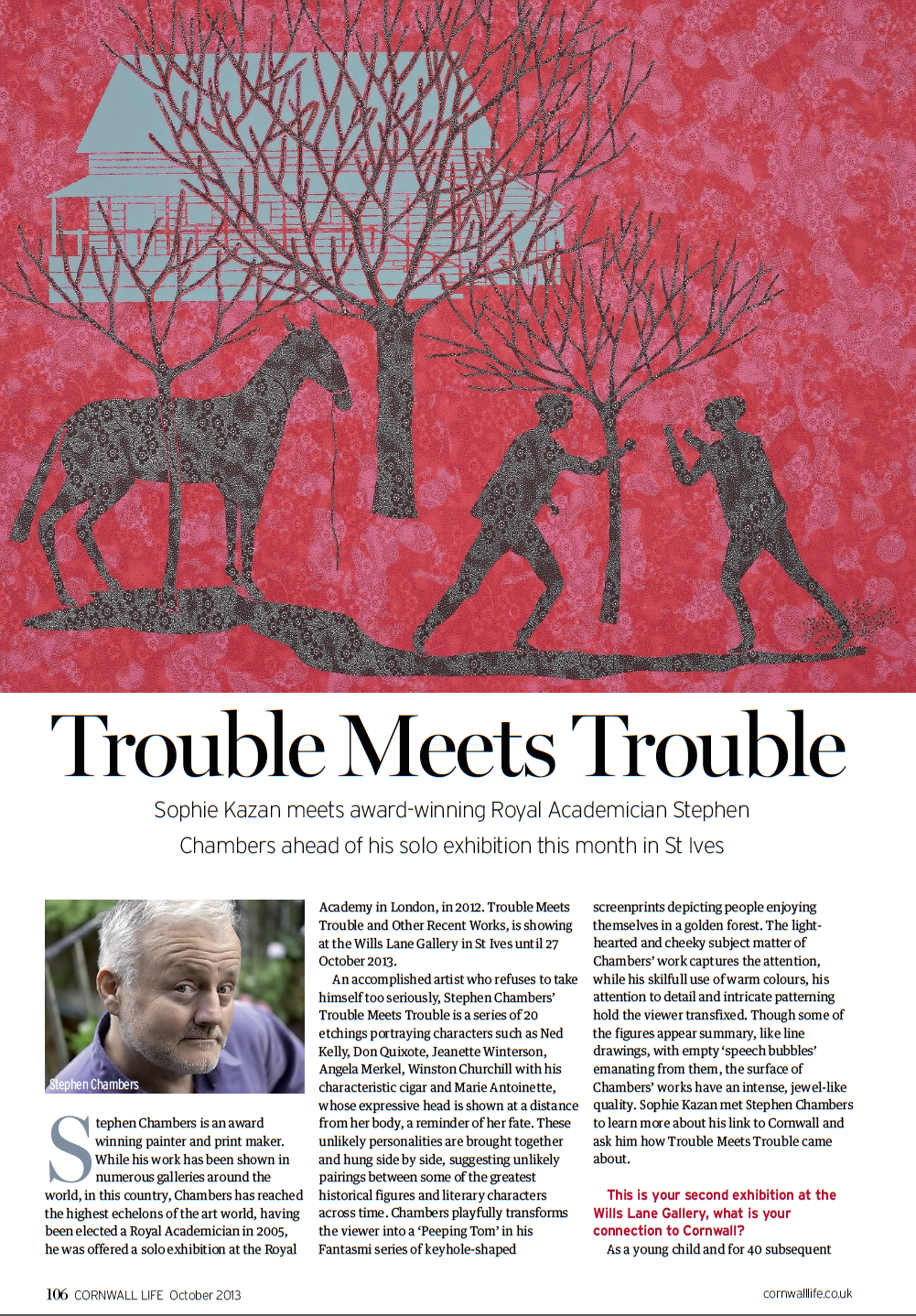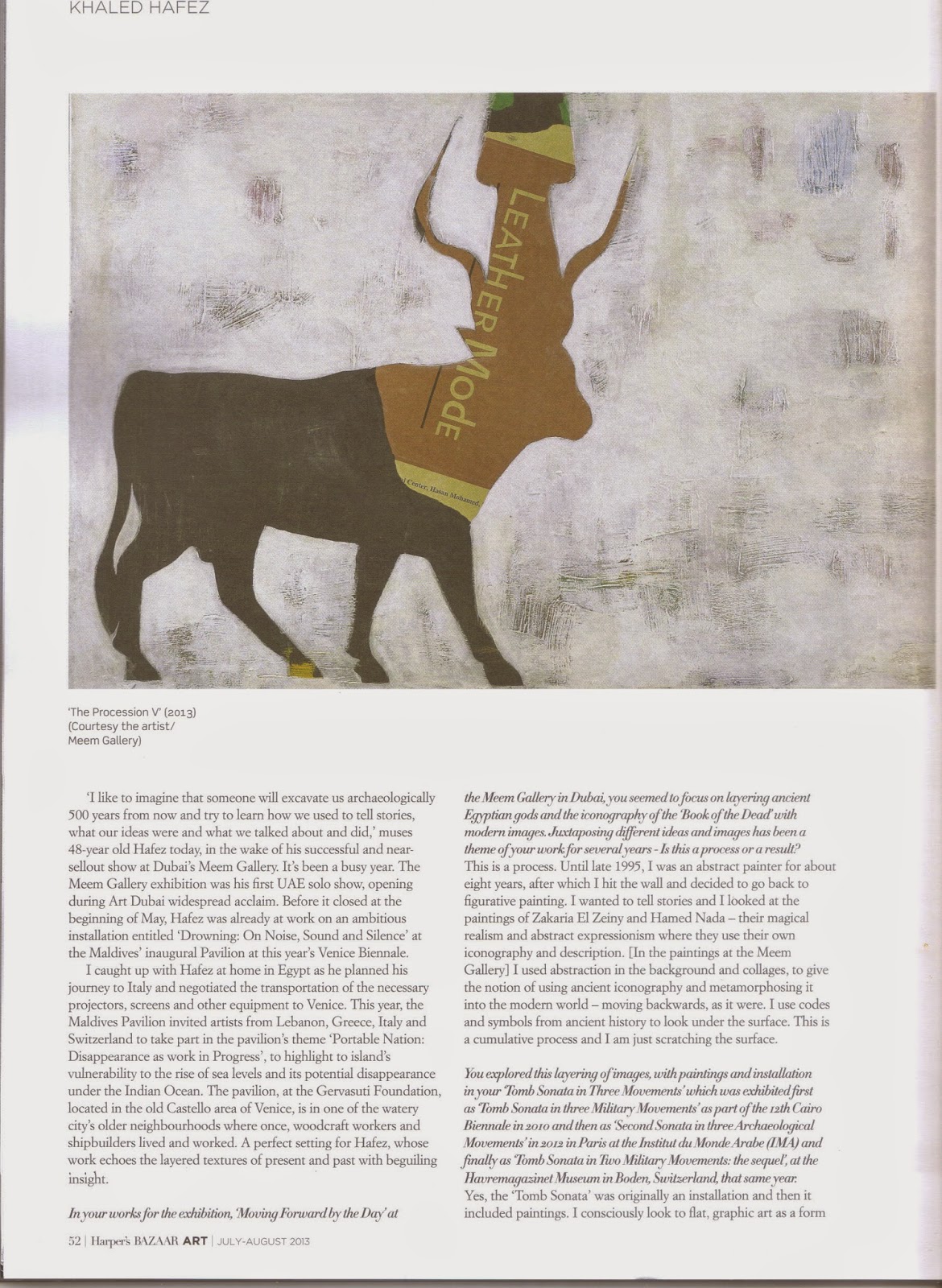(Masquerade Magazine - Issue 5, March 2014)
This article was hard work - it was also the most fun I have ever had researching and writing an article: I met lots of new people, such as the team at Sa*ce; I learnt lots of new facts about metalwork snakes from the team at Johnny Farah in Beirut; and it was a fantastic opportunity to get back in touch with the wonderful Amr Ali (Body Amr).
Articles about inspiring people and exciting places - written for UK and international magazines.
Friday 10 October 2014
Trouble Meets Trouble
(Cornwall Life, October 2013)
Stephen Chambers is an award winning painter and print maker. While his work has been shown in numerous galleries around the world, in this country, chambers has reached the highest echelons of the art world, having been elected a Royal Academician in 2005, he was offered a solo exhibition at the Royal Academy in London, in 2012.
Stephen Chambers is an award winning painter and print maker. While his work has been shown in numerous galleries around the world, in this country, chambers has reached the highest echelons of the art world, having been elected a Royal Academician in 2005, he was offered a solo exhibition at the Royal Academy in London, in 2012.
Thursday 9 October 2014
The Art of Hajj by Venetia Porter
(Islamic Arts Magazine, July 2012)
‘The Hajj: Journey to the Heart of Islam’ exhibition took place at the British Museum this year.

It was curated by Venetia Porter, curator of the Islamic and Contemporary Middle East Department, author of ‘The Art of Hajj’. This is not a collection of academic essays on art, such as those contained in the large exhibition catalogue that was published at the same time. It is a small and beautifully set out book that focuses on key objects in the Hajj exhibition. More: ‘The Hajj: Journey to the Heart of Islam’ exhibition took place at the British Museum this year. It was curated by Venetia Porter, curator of the Islamic and Contemporary Middle East Department, author of ‘The Art of Hajj’. This is not a collection of academic essays on art, such as those contained in the large exhibition catalogue that was published at the same time. It is a small and beautifully set out book that focuses on key objects in the Hajj exhibition. More
Lygia Pape
The Magnitized Spaces retrospective exhibition at the Serpentine Gallery, London (until 19 February 2012) is the first major exhibition of the work of the Neo-Concretist Brazilian artist Lygia Pape. It is a wonderful introduction to the work of Pape and indeed Brazilian Art during the 1960s and 1970s.
Eat me is a video cleverly placed at the entrance to the exhibition. With its soft music, it suggests an obscene B movie, but when watched carefully, the man and then the woman's lips, moving slowly and suggestively seem almost playful.

Expressive and colourful wooden blocks punctuate a white wall. They express Pape's Livro do Tempo (Book of Time) made up of so many shifts of colour, rhythms and shapes.
Ttéia 1 (Web) is a spectacularly assembled piece - haunting shafts of light are created by tightly suspended golden threads. They produce a shadowy and complex web in the dark gallery space.
Pape’s works are summary and complex. Though created over fifty years ago, they have not lost their power or relevance. The exhibition will continue to tour, before heading back to Brazil next year.
Parviz Tanavoli: The Heech
Does Nothingness have shape?
Anyone who has seen the 'Heech' sculptures of Iranian sculptor Parviz Tanavoli would most certainly say ‘Yes!’.
Probably the most well-known and the greatest Iranian sculptor of modern times, Parviz Tanavoli has, for the past six years been working and reworking the 'Heech' shape. Derived from the Iranian word 'Heech', which denotes nothingness or nil, the sharp pinnacle and rounded base of this form has inspired Tanavoli in various mediums and many different sizes.

Probably the most well-known and the greatest Iranian sculptor of modern times, Parviz Tanavoli has, for the past six years been working and reworking the 'Heech' shape. Derived from the Iranian word 'Heech', which denotes nothingness or nil, the sharp pinnacle and rounded base of this form has inspired Tanavoli in various mediums and many different sizes.

The word first came to Tanavoli in 2005, when he was looking for a way to express his indignation at the treatment of Iranian and Arab prisoners by the United States in the Guantanamo Bay detention centre in Cuba. He wished to express something greater than the powerlessness and nothingness that was happening in everyday life. And so the 'Heech' was born.
Geometric Sculpture
Simple Matters, is an exciting new exhibition of works by geometric sculptor George Meyrick at the Exchange in Penzance. It relates to space, colour and illusion – three things that can astonish even the most high-brow exhibition viewer. I saw children racing happily around the exhibition, pointing and exclaiming at the huge shapes protruding from or retreating into the walls of the white gallery. The shapes lunging out of the wall are made of plywood or painted in carefully chosen shades of matt or gloss, to give a sense of three-dimension.
Meyrick uses colour as a tool, which directs the eye “to bounce” energetically over the sculptures with enormous energy. He mixes colours creating soft and hard tones, drawing his audience’s attention in and out of shape and along the wall. Two of his works are created with coloured string, tightly suspended like line drawings in mid-air.
Meyrick’s work is vibrant and energetic. “I enjoy playing with space,” said George Meyrick to visitors at the opening of the exhibition on 27 January. He also encouraged his audience to challenge the sculptures by moving around them, even to get in to them, in the case of the string scuptures.
Meyrick was born in 1953. He attended St Martin’s School of Art, Brighton Polytechnic and the Chelsea School of Art and has exhibited consistently since graduating in 1975, as part of group exhibitions and solo exhibitions, such as the one currently being shown in Penzance. He cites the Russian constructivists and American minimalists as guiding influences in his work. The exhibition will continue until 14 April 2012.
On 7 April at 2pm George Meyrick will be discussing The Art of Making, at the Newlyn Art Gallery.
Meyrick was born in 1953. He attended St Martin’s School of Art, Brighton Polytechnic and the Chelsea School of Art and has exhibited consistently since graduating in 1975, as part of group exhibitions and solo exhibitions, such as the one currently being shown in Penzance. He cites the Russian constructivists and American minimalists as guiding influences in his work. The exhibition will continue until 14 April 2012.
On 7 April at 2pm George Meyrick will be discussing The Art of Making, at the Newlyn Art Gallery.
See: www.newlynartgallery.co.uk
Naz Shahrokh: The Nature of Art
(Islamic Arts Magazine, July 2012)
I first came into contact with the conceptual art of Naz Shahrokh at a group exhibition at Ghaf Gallery in Abu Dhabi. The vibrant colour, careful structure and contemplative quality of her work appeals to the senses. On a long, white gallery wall hung three rows of white boxes each containing a silver maple leaf on which was painted a desert landscape in miniature.

I was impressed by the precision of the paintings and the harmony created by the intense colour of the simple leaf shape in its pure white box. The jewel-like painting on each leaf, recalled Persian miniature painting. Naz admitted that this was a subconscious influence. She always insists that the
emphasis should lie on the use of natural recycled materials. She finds new uses for used or lost objects and recycles materials to form the basis of her installations. More
Pop Up Reality
(BrownBook Magazine, Issue #34)
Wherever Rana Salam has lived, entering her home is like stepping into an alternate reality. Heavily influenced by the popular art of the Middle East, from Lebanon and Egypt, even when she lived in London - first in a cosy flat in Bayswater, then in a house with a studio up-front in the fashionable and bohemian district of Ladbroke Grove - her place has always been overflowing with her archive of inspiring designs, film posters and bright colours.
In 2O1O, she relocated with her husband and two children to her native Beirut and now the graphic artist and designer lives in a spacious apartment-cum-studio in the heart ofthe residential neighborhood of Achrafieh. More
The Language of the Universe
(W Magazine, KSA August 2012 edition)

Intricate pointed stars and interlacing polygons are found painted, carved or engraved throughout Islamic Art and architecture. We find examples of stone, metal, wood, glass, leather and tile-work, in religious and secular buildings, textiles, carpet-weaving designs, as well as the borders and cabochons of illuminated manuscripts and Korans dating back to the eighth century.
Joe Kesrouani: Beirut Remixed
(Reorient Magazine, 1 October 2012)
Joe Kesrouani is a busy man. Recently, he took part in a project entitled Hoods for Heritage, wherein the Porsche Centre in Lebanon offered 16 artists the chance to decorate the bonnet of its 911 model in any way they pleased.
Kesrouani’s own contribution – a black and white halftone vinyl print of one of his more provocative pictures of a rear-view of a woman’s torso – was exhibited alongside the work of other young, aspiring Lebanese artists and designers such as Ayman Baalbaki, Zeina El Khalil, and Nada Debs in the Villa Audi mansion in Beirut. As part of the initiative, the bonnets were later auctioned off in aid of the Lebanese National Heritage Foundation. More
See The Light
Documenting the sociopolitical upheavals in the Middle East through Photography.
(Reorient Magazine, 19 November 2012)
London has been undergoing its own Arab Spring of sorts in the past months, as a steady flow of exhibitions and cultural events focusing on the Middle East have been flourishing around the capital in rapid succession.
In the summer of 2011, Shubbak, London’s first festival of contemporary Arab arts & culture was launched by mayor Boris Johnson, and was quickly followed by the city’s second Nour Festival of Arts in October of that year. In January, just a few months later, the British Museum launched its Hajj exhibition, and in almost no time, an assortment of similarly themed exhibitions blossomed around London.

This November, less than two weeks after Edge of Arabia’s dazzling #COMETOGETHER exhibition in East London’s Truman Brewery warehouse, the Victoria and Albert Museum opened the Light from the Middle Eastphotography exhibition. MORE
Wednesday 8 October 2014
Nour Festival
(Harpers Bazaar Art ♯5, December 2012)
From toothsome desserts to the Arab Spring - London's Nour Festival attempts a distillation of Arab culture for the UK capital this autumn. Sophie Kazan was there.
If Horses Could Fly
(Harpers Bazaar Art, #5, December 2012)
Upon meeting Lea Sednaoui, you quickly realise that you are in
Upon meeting Lea Sednaoui, you quickly realise that you are in
Three Points of Contact, Review
(Aesthetica Magazine, Exhibition Blog, January 2013)
An important part of a museum or gallery curator’s role is to engage with the visitor and make their experience an exciting and fulfilling one. Three Points of Contact is the first of a new “roving residency” concept that focuses on the collaboration between artists, curators and gallery visitors and allows the latter not only to view artworks in an exhibition, but also to witness the creative process and the environment in which they came about. MORE
Peter Fraser - Retrospective
(Aesthetica Magazine, Exhibition Blog, February 2013)
Entering photographer Peter Fraser’s retrospective exhibition at the Tate St Ives is like holding a magnifying glass up to everyday life. Like a Master painter, Fraser pays great attention to composition, colour, light and shadows. His subjects are ordinary objects; a book, a shell, a statue, that have played a part or simply been a witness to his everyday life. MORE
The Dark Rooms: Review
(Aesthetica Magazine, Exhibition Blog, February 2013)

Lost For Words
(Islamic Arts Magazine, 19 July 2013)
This summer two exhibitions of Syrian art inspired by the uprising in 2011, are being shown in London.
‘#WithoutWords – Emerging Syrian Artists’, draws together paintings, drawings and sculptures made in Syria then smuggled out of the country, or by Syrian artists living in exile. The exhibition is designed not only to raise awareness of contemporary Syrian artistic tradition, but also to provide funds for the humanitarian charity, Mosaic Syria.
Trouble Meets Trouble
(Cornwall Life Magazine, October 2013)
Sophie Kazan meets award-winning Royal Academician Stephen Chambers ahead of his solo exhibition this month in St Ives. more
Friday 3 October 2014
Khaled Hafez: Forensically Formal
(Harpers Bazaar Art - July 2013)
Khaled Hafez's iconoclastic canvases span eras, cultures and the minutia of civilisations in kaleidoscopic panoramas, adding colour and modernity to ancient iconography.
Sophie Kazan met him to discuss his practise and what an archaeologist 500 years hence might deduce about these turbulent times in which we live...
A GLIMPSE OF ANOTHER WORLD
The Chanel Mobile Art Pavilion by Zaha Hadid
(Open Arts Journal, Issue 2)
This review of the Mobile Art Pavilion (MAP) designed by Zaha Hadid for the fashion house Chanel considers the innovative form, materials and space of the building, and ponders the irony of its permanent installation in the grounds of Paris’ Institute of the Arab World. More
(Open Arts Journal, Issue 2)
This review of the Mobile Art Pavilion (MAP) designed by Zaha Hadid for the fashion house Chanel considers the innovative form, materials and space of the building, and ponders the irony of its permanent installation in the grounds of Paris’ Institute of the Arab World. More
Sax Impey: The Light And The Veil
(Aesthetica Magazine blog, 24 September 2013)
Sax Impey is a Cornish artist, who was born in Penzance, trained at Newport in Wales, and now works in the historic Porthmeor Studios in St Ives. The Light and The Veil, his latest exhibition at the Millennium Gallery in St Ives, has one subject: The sea. More
The Lost Youth of War
How Bolitho School in Penzance Will Commemorate The First World War.
One of the most striking and moving aspects of the First World War was that of a generation of young men going into battle, never to return - thereby wiping out a large part of a generation. It is also well-documented that many boys, keen to do their bit, lied about their age in order to be counted.
One of the most striking and moving aspects of the First World War was that of a generation of young men going into battle, never to return - thereby wiping out a large part of a generation. It is also well-documented that many boys, keen to do their bit, lied about their age in order to be counted.
Thursday 2 October 2014
Riding Fat - the fat bike.
(Cornwall Life Magazine, August 2014)
On a recent trip to Dubai, I was astonished to see a bicycle with thick, monster-truck wheels, powerful and other-worldly. Was it a mountain bike? A hybrid motorcycle? It was, in fact, a fat bike – an exciting new phenomenon which is set to invade Kernow (and the UK) over the coming year.
On a recent trip to Dubai, I was astonished to see a bicycle with thick, monster-truck wheels, powerful and other-worldly. Was it a mountain bike? A hybrid motorcycle? It was, in fact, a fat bike – an exciting new phenomenon which is set to invade Kernow (and the UK) over the coming year.
Bita Ghezelayagh: The Letter That Never Arrived
(Harpers Bazaar Art, July 2013)
Bita Ghezelayagh’s ‘The Letter That Never Arrived’ (Nameh-l ke hargez naresid) at London’s Rose Issa Projects analogised the artistic and cultural tradition of Iran to a thewarted message or a letter, intercepted en route to its intended destination.
Bita Ghezelayagh’s ‘The Letter That Never Arrived’ (Nameh-l ke hargez naresid) at London’s Rose Issa Projects analogised the artistic and cultural tradition of Iran to a thewarted message or a letter, intercepted en route to its intended destination.
An Anonymous Street Artist
(Aesthetica Magazine Blog - 28 August 2013)
Already well known in international urban art circles, it has not yet been two years since Cornwall’s celebrated street artist came up with the idea for BotMan, an innocent robot with a heart. Since then, his BotMan avatar has taken him into international urban art circles; he has had three sell-out shows, has been represented by a London Gallery, had work shown at Basel Miami and rubbed shoulders with UK urban artists such as Banksy and Dface.
Sophie Kazan of Aesthetica caught up with BotMan for a virtual chat about the business of being a successful, anonymous artist. More
Subscribe to:
Posts (Atom)





























.jpg)